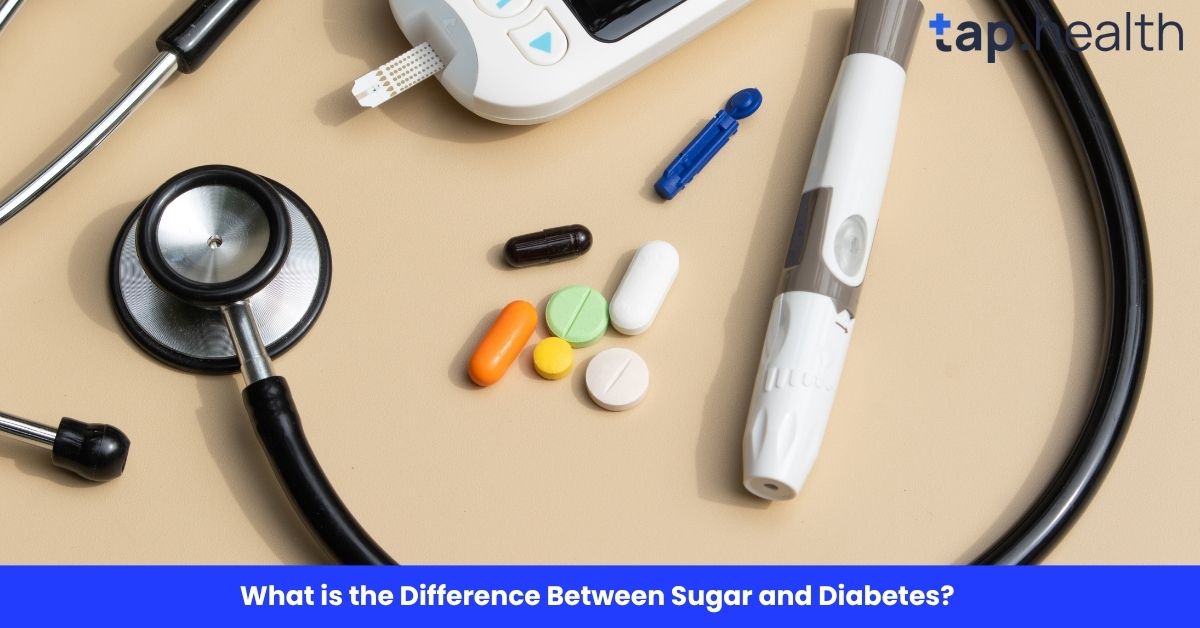When people talk about sugar and diabetes, it’s common to hear the terms used interchangeably, but they are not the same. While sugar is an essential part of our diet, diabetes is a chronic condition that occurs when the body cannot effectively process sugar. This blog will help clarify the difference between sugar and diabetes, how they are related, and the impact of sugar on diabetes management.
Whether you’re trying to learn more for your own health or to understand the science behind diabetes, this blog will provide you with a comprehensive overview. Let’s dive in!
What is Sugar?
Sugar, in the simplest terms, is a type of carbohydrate that provides energy to the body. It is found naturally in many foods, such as fruits and vegetables, but it is also added to many processed foods to enhance flavour. The most common types of sugar you encounter are glucose, fructose, and sucrose.
Types of Sugar:
- Glucose: This is the primary form of sugar used by the body for energy. It’s found in carbohydrates like bread, rice, and potatoes.
- Fructose: Found naturally in fruits and honey, fructose is a type of sugar that is processed differently by the liver.
- Sucrose: Commonly known as table sugar, sucrose is a combination of glucose and fructose. It is often added to foods and beverages.
How Does Sugar Affect the Body?
Sugar is essential for providing energy to the body, especially the brain, muscles, and other organs. When you eat sugar, it is broken down into glucose, which enters the bloodstream. Insulin, a hormone produced by the pancreas, helps move glucose from the blood into the cells for energy.
However, consuming too much sugar, especially refined sugar, can lead to health problems, including weight gain, high blood pressure, and an increased risk of chronic diseases like diabetes.
What is Diabetes?
Diabetes is a group of diseases that occur when the body either does not produce enough insulin or cannot use insulin properly. This leads to high blood sugar levels, which, over time, can cause serious complications such as heart disease, kidney damage, and nerve damage.
There are two main types of diabetes: Type 1 and Type 2.
1. Type 1 Diabetes:
Type 1 diabetes is an autoimmune condition where the body’s immune system attacks and destroys the insulin-producing cells in the pancreas. As a result, people with Type 1 diabetes need to take insulin daily to manage their blood sugar levels.
2. Type 2 Diabetes:
Type 2 diabetes is more common and occurs when the body becomes resistant to insulin or when the pancreas cannot produce enough insulin. This type is often associated with lifestyle factors like poor diet, obesity, and lack of exercise. Type 2 diabetes can often be managed with lifestyle changes, oral medications, and sometimes insulin.
The Relationship Between Sugar and Diabetes
The key difference between sugar and diabetes is that sugar, in itself, does not cause diabetes. However, the way sugar is processed in the body can significantly affect people with diabetes. Let’s break down the relationship between sugar and diabetes.
1. How Sugar Affects People with Diabetes
For people with diabetes, the body’s ability to manage sugar is compromised. This means that even though sugar is a natural energy source, people with diabetes must be careful about how much sugar they consume because their bodies may not process it correctly.
- In Type 1 Diabetes, since the body cannot produce insulin, people must inject insulin or use an insulin pump to regulate blood sugar levels.
- In Type 2 Diabetes, the body either resists the effects of insulin or does not produce enough. The result is high blood sugar levels, which can lead to complications if not managed properly.
2. What Happens to Sugar in the Body of a Person with Diabetes?
In a healthy person, after consuming sugar, insulin helps move the sugar (glucose) from the blood into the cells. However, in someone with diabetes:
- In Type 1 Diabetes, since the body cannot produce insulin, glucose stays in the blood, leading to high blood sugar levels (hyperglycemia).
- In Type 2 Diabetes, the cells become resistant to insulin, or the pancreas cannot produce enough insulin, causing glucose to remain in the blood.
3. Effects of High Sugar Intake in Diabetics
Consuming too much sugar can spike blood sugar levels, making it harder for people with diabetes to manage their condition. High blood sugar over time can lead to:
- Fatigue: Due to the inability of the cells to get enough glucose.
- Nerve Damage: Prolonged high blood sugar can damage blood vessels and nerves.
- Heart Disease: Increased sugar levels raise the risk of heart problems in people with diabetes.
Therefore, maintaining a balanced diet with controlled sugar intake is crucial for managing diabetes.
The Impact of Sugar on Type 1 and Type 2 Diabetes
Sugar affects Type 1 and Type 2 diabetes in different ways. While both types involve insulin issues, the way sugar is managed differs between the two.
Impact on Type 1 Diabetes:
In Type 1 diabetes, since the body cannot produce insulin, it is necessary to balance sugar intake with insulin administration. If blood sugar levels rise too high due to excessive sugar intake or missed insulin doses, a person with Type 1 diabetes can develop diabetic ketoacidosis (DKA), a dangerous condition that can lead to coma.
Impact on Type 2 Diabetes:
In Type 2 diabetes, the body either resists insulin or does not produce enough. Sugar intake needs to be controlled because excessive consumption can exacerbate insulin resistance. Consuming too much sugar can increase the risk of complications such as cardiovascular disease and kidney damage.
How to Manage Sugar Intake in Diabetes
Managing sugar intake is crucial for controlling blood sugar levels in diabetes. Here are some tips to help manage sugar intake:
1. Eat a Balanced Diet
Eating a balanced diet with whole grains, lean proteins, healthy fats, and plenty of vegetables can help stabilize blood sugar levels. Avoiding highly processed foods and sugary snacks is essential.
2. Monitor Blood Sugar Levels Regularly
Checking your blood sugar regularly helps track how different foods, including sugar, affect your body. This will help you understand how much sugar your body can handle.
3. Portion Control
Instead of avoiding sugar completely, focus on portion control. Eating small amounts of sugar in moderation, along with other foods that help regulate blood sugar, can make a significant difference.
4. Exercise Regularly
Exercise helps your body use insulin more effectively. It also helps lower blood sugar levels and can reduce insulin resistance in people with Type 2 diabetes.
Real-Life Scenario
Ravi enjoys sweetened beverages every day—tea with extra sugar, desserts after meals, and packaged juices. Over time, he starts feeling tired and thirsty more often. After a check-up, he learns his fasting blood sugar is high, and his doctor diagnoses him with prediabetes.
By reducing his sugar intake and making healthier food choices, Ravi manages to bring his blood sugar levels back to normal within a few months. This real-life example shows that monitoring sugar intake plays a vital role in preventing diabetes.
Expert Contribution
Endocrinologists and nutrition experts emphasize that it’s not just about avoiding sugar but about maintaining overall dietary balance. Refined sugars quickly raise blood glucose levels, putting stress on the pancreas to produce more insulin.
Experts recommend replacing refined sugar with natural sweeteners (like stevia or small amounts of honey) and focusing on complex carbs, whole grains, fruits, and vegetables. Regular exercise also helps the body use insulin more efficiently.
Recommendations Grounded in Proven Research and Facts
- Limit added sugars: The WHO advises keeping added sugars below 10% of daily calorie intake, ideally under 5%.
- Read food labels: Many processed foods contain hidden sugars (look for terms like dextrose, maltose, or corn syrup).
- Balance meals: Pair carbohydrates with fiber and protein to slow down sugar absorption.
- Stay active: Regular physical activity improves insulin sensitivity and helps maintain healthy blood sugar levels.
- Regular monitoring: Checking your blood glucose periodically helps catch early signs of diabetes.
How Tap Health Can Help You Manage Diabetes Better
Tap Health is designed to make diabetes care simpler, smarter, and more personalized. With its AI-powered tools and real-time insights, it helps you take full control of your health every day.
Here’s how Tap Health supports you:
- Smart Meal Tracking: Take a picture of your meal and instantly get accurate carb and calorie counts, helping you make better food choices.
- Personalized Diet Guidance: Get meal recommendations tailored to your blood sugar goals and preferences.
- Glucose Monitoring Made Easy: Track your blood sugar readings and view clear trends to understand what affects your levels most.
- AI Health Coaching: Receive 24/7 support and expert-backed advice for managing food, exercise, sleep, and stress.
- Medication & Reminder Alerts: Never miss a dose or check—Tap Health keeps you on schedule effortlessly.
- Actionable Insights: The app analyzes your data and offers simple, effective tips to help you stay consistent and motivated.
Frequently Asked Questions (FAQ) on What is the Difference Between Sugar and Diabetes?
1. What is the main difference between sugar and diabetes?
Sugar is a type of carbohydrate that provides energy to the body, while diabetes is a condition where the body cannot regulate blood sugar levels effectively, leading to high or low blood sugar.
2. Can eating sugar cause diabetes?
Eating too much sugar does not directly cause diabetes. However, a diet high in sugar can lead to obesity, which increases the risk of developing Type 2 diabetes.
3. How does sugar affect blood sugar levels in diabetics?
Sugar affects blood sugar levels by raising them. In people with diabetes, the body has difficulty processing sugar, leading to elevated blood glucose levels.
4. What are the best ways for people with diabetes to manage sugar intake?
The best ways to manage sugar intake include eating a balanced diet, monitoring blood sugar levels regularly, controlling portions, and exercising regularly.
5. What is the difference between Type 1 and Type 2 diabetes in terms of sugar management?
In Type 1 diabetes, the body cannot produce insulin, so insulin must be injected to manage sugar levels. In Type 2 diabetes, the body either resists insulin or does not produce enough insulin, and sugar levels are managed with lifestyle changes and medications.
6. Is there a safe amount of sugar for people with diabetes to consume?
Yes, people with diabetes can safely consume sugar in moderation. It is essential to monitor blood sugar levels and balance sugar intake with other foods that help control blood sugar.
Conclusion
In summary, while sugar is an essential part of a healthy diet, it can be harmful to people with diabetes if not properly managed. The key difference between sugar and diabetes lies in the body’s ability to process sugar. In people with diabetes, insulin dysfunction can lead to high blood sugar, making it crucial to manage sugar intake effectively. By understanding the role of sugar in diabetes and taking steps to control it, individuals with diabetes can live healthier lives and reduce the risk of complications.
Remember, if you or a loved one has diabetes, it’s important to work with a healthcare provider to develop a personalized plan to manage blood sugar levels and ensure a healthy, balanced lifestyle.



